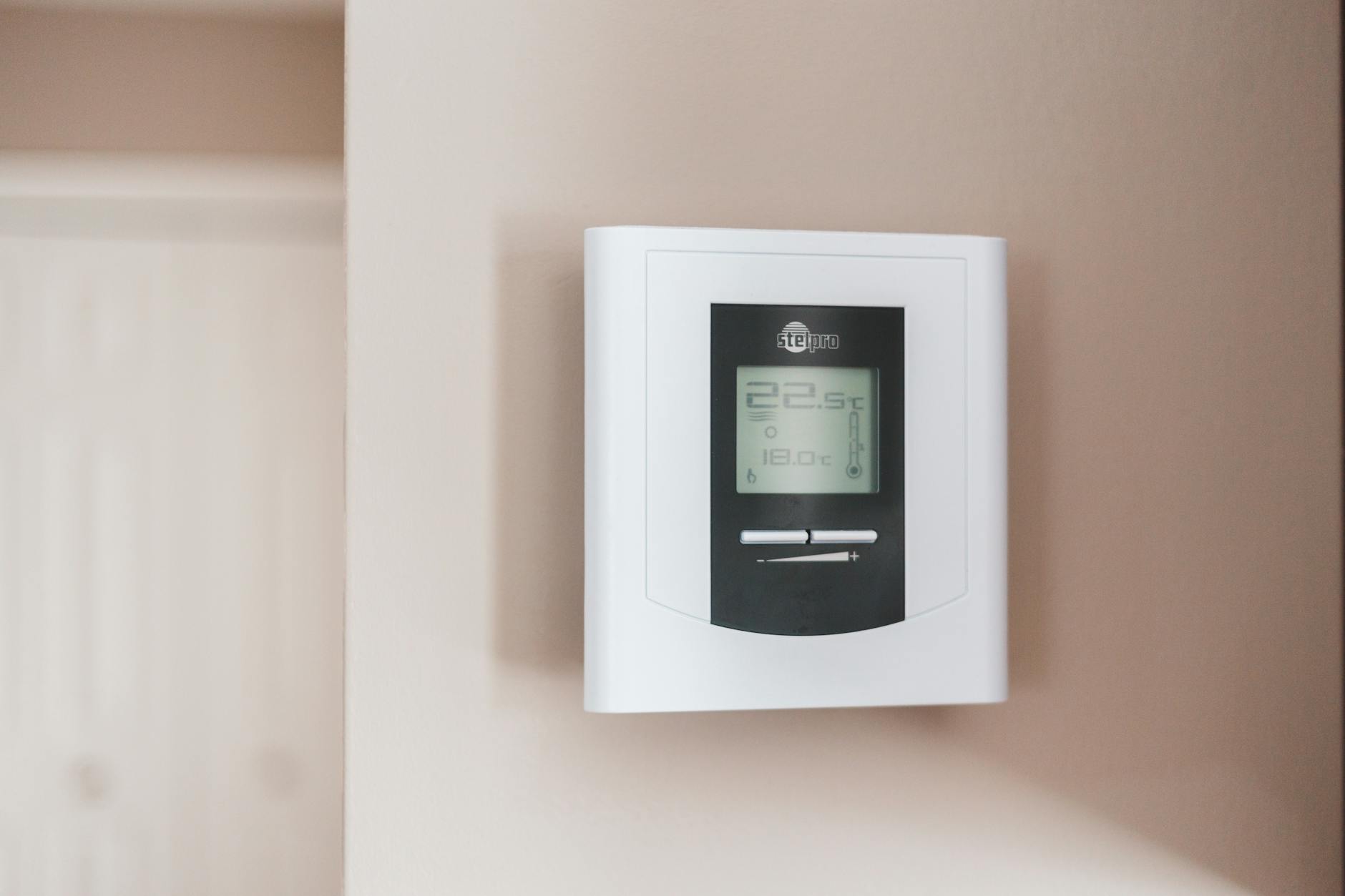Imagine a thermostat that adjusts itself automatically, saves you money, and keeps your home comfortable without you lifting a finger. That’s exactly what smart thermostats bring to the table. These devices are transforming how we heat and cool our homes by combining advanced technology with everyday convenience. From learning your habits to syncing with your smartphone, they’re designed to cut down energy waste while making life easier. Whether you’re aiming to lower utility bills or create a smarter living space, these systems offer a practical and efficient solution.
Smart thermostats are modern devices designed to enhance the way we control our heating and cooling systems. Unlike traditional thermostats, which rely on manual adjustments or basic programming, smart thermostats are Wi-Fi-enabled and packed with advanced features that learn your preferences, offer remote control, and provide insights into your energy use. These devices aim to strike the perfect balance between comfort, convenience, and energy efficiency. Here’s a closer look into their standout features and how they function.
Smart thermostats stand out because of their cutting-edge functionalities that make managing your home environment seamless. Here are the key features that make them unique:
Photo by Brett Jordan 
What makes these devices truly “smart” is their ability to gather data and take automated actions based on it. Let’s break down how they function from the inside out.
By combining these technologies, smart thermostats manage to create a comfortable home climate while minimizing energy use. Pretty impressive, right? This perfect mix of intelligence, connectivity, and automation is why many consider smart thermostats to be an essential upgrade for modern homes.
Smart thermostats are proving to be more than just gadgets—they’re practical tools that improve how we manage heating and cooling. Whether you’re looking to save money, simplify your life, or lower your carbon footprint, these devices come with substantial advantages. Let’s explore some of the key benefits they offer.
One of the biggest selling points of smart thermostats is their ability to optimize energy use. Unlike traditional models, these devices use sensors, data, and learning algorithms to control temperature intelligently. They aim to heat or cool only when necessary.
Smart thermostats often include features like geofencing to know when you’re home or away. For example, if you leave for work and forget to turn the thermostat down, it will automatically adjust. Many models can also take outside weather conditions into account, fine-tuning the temperature without wasting energy.
The result? Higher efficiency without sacrificing comfort. According to ENERGY STAR, certified smart thermostats can save up to 10-15% on annual heating and cooling costs. Over time, this small adjustment in temperature management dramatically reduces wasted energy.
Photo by Erik Mclean 
Energy efficiency doesn’t just help the planet—it also helps your wallet. Smart thermostats are an effective way to lower your monthly utility costs. By precisely controlling your HVAC system based on real-time needs and usage patterns, these devices can trim expenses significantly.
For instance, studies show that households using smart thermostats experience savings of 8-15% on heating and cooling bills annually. In practical terms, this can mean saving between $50-$150 per year, depending on your location and system. Some models, such as the Nest Learning Thermostat, report savings as high as 12% on heating and 15% on cooling, making the upfront investment pay off relatively quickly.
Utility providers and government programs often offer rebates to encourage homeowners to adopt energy-conscious technologies. Taking advantage of these incentives can make smart thermostats even more accessible and cost-efficient.
Modern living is about making things easier, and smart thermostats excel at doing just that. With features like mobile app control, voice assistant integration, and automated scheduling, they make managing your home’s comfort effortless.
Want to cool your home on the way back from a weekend trip? Use the app. Prefer voice commands through Alexa or Google Assistant? Done. Many smart thermostats even learn your daily habits over time, creating a personalized schedule that adjusts temperatures without you needing to micromanage settings.
Even better, some models send you reminders for HVAC maintenance, like changing filters. These small conveniences add up, making smart thermostats not just energy savers but time savers too. They’re the ultimate “set-it-and-forget-it” devices, giving you one less thing to think about in your daily routine.
Incorporating a smart thermostat into your home isn’t just about high-tech appeal—it’s about genuine benefits that enhance your lifestyle in measurable ways.
Smart thermostats are more than just temperature controllers—they’re becoming the backbone of modern smart homes. By connecting seamlessly with other devices, they help create a network of intelligent systems that work together for your convenience. Let’s look at how these integrations elevate your living space.
Smart thermostats are designed to work harmoniously with a wide range of other smart devices, making your home truly interconnected. Imagine walking into a room where lights dim automatically, blinds lower, and the temperature adjusts—all to your liking.
Some common examples of integration include:
This level of cohesion not only enhances convenience but also boosts energy efficiency. Many systems use shared data, like room occupancy or outside temperatures, to make automatic adjustments. It’s like having a choreographed system managing the fine details of your environment.
Photo by Jakub Zerdzicki 
One of the standout features of smart thermostats is their compatibility with voice assistants like Amazon Alexa, Google Home, or Apple HomeKit. These voice-activated platforms make managing your thermostat as easy as saying, “Set my living room to 72 degrees” while you relax on the couch.
Here’s what makes voice and app control a game changer:
Voice and app controls add a significant layer of personalization and ease. Being able to manage your thermostat remotely makes your home not just smart, but intuitive. Now the idea of walking into an uncomfortable room feels outdated. Smart thermostats keep the focus on your convenience and comfort, every step of the way.
Adopting smart thermostats isn’t just about convenience or cost savings—it plays a significant role in reducing environmental strain. These smart devices are designed to optimize energy consumption, helping us take a step toward a more sustainable way of living. Whether it’s by cutting down on wasted electricity or minimizing emissions, smart thermostats offer a greener alternative for maintaining comfortable homes.
Smart thermostats excel at minimizing energy wastage, which in turn reduces greenhouse gas emissions. Traditional heating and cooling systems often run unnecessarily, especially when no one is at home. Smart thermostats prevent this through automated adjustments based on real-time occupancy and weather data.
The ripple effect of these capabilities is significant. Researchers suggest that widespread adoption of smart thermostats could reduce global carbon dioxide emissions by up to 7 gigatons in the coming decades. That’s like taking millions of cars off the road for good.
Governments and utility companies understand the role smart thermostats play in environmental conservation. To encourage adoption, many offer financial incentives like rebates or discounted pricing, making these devices more accessible to homeowners.
These incentives not only make the initial investment more affordable but also amplify the environmental benefits by encouraging widespread use. Check with your local utility or the ENERGY STAR rebate finder to see which programs you qualify for.
Photo by Andersen EV 
Just like electric vehicles conserve energy on the road, smart thermostats build sustainable habits at home.
As smart thermostats redefine how we manage indoor climates, it’s important to weigh the potential challenges alongside their many benefits. While these devices promise convenience and energy savings, they also present practical barriers and privacy risks that homeowners should consider carefully.
Installing a smart thermostat can range from straightforward to daunting, depending on your home’s existing HVAC system and the thermostat model. Some systems play nicely with plug-and-play devices, while others feel more like assembling furniture without instructions.
Before purchasing, always check compatibility guides provided by manufacturers. Skipping this step might leave you with a high-tech device that doesn’t fit into your home’s older heating and cooling infrastructure.
Smart thermostats collect a staggering amount of data—not just on your home’s temperature but also your daily habits, occupancy patterns, and even GPS locations through features like geofencing. While this information makes them efficient, it also raises concerns about privacy and security.
How can you protect yourself?
While many brands are stepping up efforts to improve transparency and strengthen security protocols, privacy concerns remain a key consideration. Balancing convenience with peace of mind requires homeowners to be informed consumers who take proactive steps to secure their smart devices.
The journey of the thermostat reflects humanity’s persistent pursuit of achieving comfort and efficiency at home. From simple mechanical devices to the sophisticated, smart systems we know today, thermostats have come a long way. Each stage in their development marked a leap in technology and functionality, reshaping the way we control indoor climates.
The earliest thermostats were simple devices with one goal: regulate temperature. The concept dates back to the early 17th century when Dutch inventor Cornelius Drebbel created a rudimentary mercury thermostat for an egg incubator. While primitive by today’s standards, it laid the foundation for the idea of thermostatic control.
Fast forward to 1830, Scottish chemist Andrew Ure introduced the first bimetallic thermostat. This innovation used two metals with different expansion rates to control steam boiler temperatures. Then came Warren Johnson in 1883, who developed an electric thermostat capable of signaling furnace adjustments. His breakthrough gave homeowners an unprecedented ability to manage indoor heat levels remotely and also led to the founding of Johnson Controls, a company still recognized today.
By 1906, Mark Honeywell built on these concepts with the first programmable thermostat. This model allowed users to choose desired temperatures for specific times of the day—a game-changer for achieving comfort. The 1950s brought the rise of dial-controlled thermostats. While basic, these became household staples, providing manual control for heating and cooling.
In the 1980s, programmable thermostats reemerged with digital displays and schedules, offering energy-saving potential as users could set heating or cooling routines in advance. However, many people found their complexity frustrating, limiting widespread use. These models were a major step toward the eventual automation we enjoy today.
The thermostat industry entered a new era in 2007 with the launch of the first smart thermostat by Ecobee. For the first time, homeowners could adjust settings remotely using Wi-Fi technology. Shortly after, the Nest Learning Thermostat hit the market in 2011, revolutionizing not only thermostat technology but also the broader smart home ecosystem. This device didn’t just allow remote adjustments; it learned user behavior, creating schedules based on preferences without requiring manual input.
Over time, additional features emerged to make smart thermostats more user-friendly and efficient. These include geofencing, which uses GPS to adjust temperatures based on your location, and integrations with smart home platforms like Amazon Alexa or Google Assistant. Brands like Ecobee and Honeywell responded to consumer demand by improving compatibility with older heating systems and introducing features like energy usage analytics.
The rise of governmental incentives in the 2010s further accelerated smart thermostat adoption. Utility companies began offering rebates for purchasing these energy-saving devices, making them more accessible for the average homeowner. The demand also surged as energy awareness grew—people wanted solutions that balanced comfort with sustainability.
Today, smart thermostats have gone beyond just controlling temperature. They integrate seamlessly into broader home ecosystems, regulate air quality, and even coordinate with renewable energy setups. With advancements in AI algorithms, they’re not just reactive but predictive—creating an environment tailored to your lifestyle.
The smart thermostat market is growing at an impressive rate, driven by increasing demand for energy efficiency, smart home adoption, and user convenience. Let’s examine some of the major players in this space and the emerging trends shaping the future of these devices.

Photo by RDNE Stock Project
A handful of industry leaders dominate the smart thermostat market, each offering unique features to cater to varying consumer needs. Here’s a closer look at the top brands transforming home climate control:
Competitors like Siemens, Bosch, and Emerson are also contributing innovations, driving new benchmarks in energy savings, connectivity, and design.
The evolution of smart thermostats is just beginning. What’s on the horizon? Here are some of the trends defining the future of these devices:
These innovations underline the rapid pace of development in the smart thermostat sector. As technology advances, these devices will become smarter, greener, and even more indispensable in our homes.
Smart thermostats are reshaping how we manage home comfort, improving efficiency and offering meaningful ways to save energy. They learn your schedule, adjust automatically, and provide insights that simplify energy use while lowering costs.
This tech isn’t just about convenience—it’s an investment in smarter, more sustainable living. With features like remote control, geofencing, and integration with smart home ecosystems, these devices make managing your home’s climate smarter and easier.
If you’re ready to cut utility bills, minimize energy waste, and enjoy personalized comfort, adding a smart thermostat to your home is a step you won’t regret. How might this kind of automation help you in your daily life? Share your thoughts or explore which model fits your needs best—you won’t look back!
